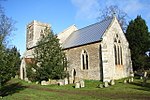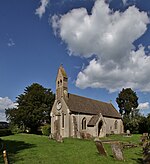Fulwell & Westbury railway station
Disused railway stations in BuckinghamshireFormer London and North Western Railway stationsPages with no open date in Infobox stationRailway stations in Great Britain closed in 1963Railway stations in Great Britain opened in 1879 ... and 1 more
Use British English from April 2017

Fulwell & Westbury was a railway station in Buckinghamshire that served the village of Westbury and the hamlet of Fulwell in neighbouring Oxfordshire, England. It opened in 1879 London & North Western Railway who had taken over the line from the Buckinghamshire Railway that year. The station consisted of one platform, a ticket office, and two waiting rooms. The station was closed for passengers in 1961 and completely in December 1963.
Excerpt from the Wikipedia article Fulwell & Westbury railway station (License: CC BY-SA 3.0, Authors, Images).Fulwell & Westbury railway station
Geographical coordinates (GPS) Address Nearby Places Show on map
Geographical coordinates (GPS)
| Latitude | Longitude |
|---|---|
| N 52.0073 ° | E -1.0874 ° |
Address
NN13 5JQ , Westbury
England, United Kingdom
Open on Google Maps









